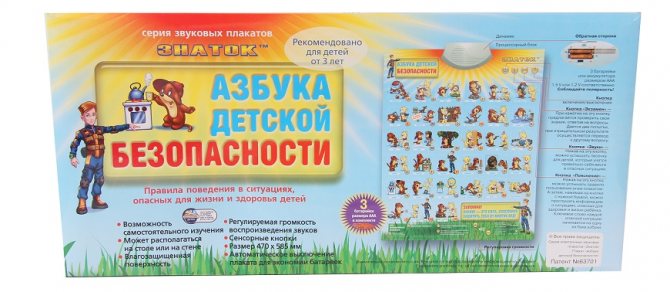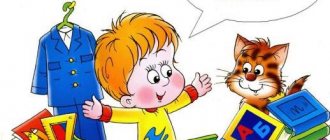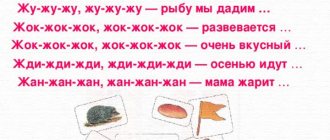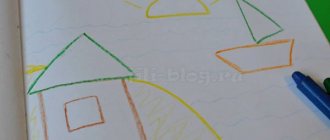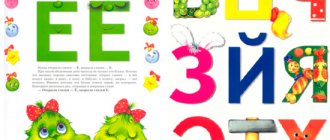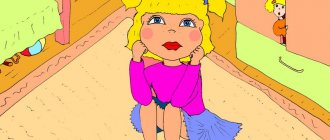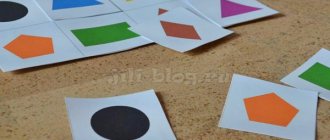To be fair, it should be noted that with a child of senior preschool age the alphabet and letters can be learned much faster than with a toddler in the first two or three years of life.
Therefore, many parents think that the game is not worth the candle. On the other hand, with early learning, letters enter the child’s life quite naturally, that is, he simultaneously learns “that this bird is called a duck, and this letter is A.” And if you approach the learning process without fanaticism, trying to present everything in a playful form, then the child will become interested in everything related to letters and, subsequently, reading. We must clearly understand that early development is not needed in order to be able to boast to relatives and friends that a baby knows all the letters at 1.5 years old, and can read at 3 years old. Also, early acquaintance with letters will not turn a toddler into a child prodigy, it will only help develop his natural abilities, and will also become a fun and useful way to spend time together.
Learning letters: where to start
In what order should I learn the letters? Do you need to learn the alphabet? Should I start with vowels or consonants?
Let's be clear, so:
1. There is no need to learn letters in alphabetical order.
2. Don’t learn letters mixed up: vowels and consonants.
3. Be the first to learn 10 letters representing vowel sounds with your child.
We wrote in detail about how to learn 10 vowels in 5 lessons. The technique is really very effective and simple. Any mother can do it.
4. It is better to learn consonants after vowels.
5. Name the sounds, not how the letter is pronounced in the alphabet.
What exactly are we developing?
First of all, of course, a passive dictionary. But it is not only he who contributes to the development of pronunciation skills. Thus, it has long been proven that the brain centers responsible for the development of fine motor skills and speech are located nearby and influence each other. Therefore, in order to ensure that the baby does not have problems with speech, it is important to pay attention to the development of fine motor skills. These could be activities such as:
- finger exercises or finger massage (at a very early age);
- sorting through cereals, small buttons, nuts;
- lacing, fastening zippers, buttons;
- screwing caps on bottles;
- finger painting on sand, semolina, flour;
- painting, modeling;
- stringing large beads on a string.
And in order for the speech apparatus to be in good shape, it needs to be constantly trained. For this purpose, special articulation gymnastics complexes have been developed. They help the child’s lips, tongue, jaws, and cheeks acquire the necessary strength, tone, mobility and controllability, learn the correct force and direction of air supply when speaking, and make speech rhythmic and beautiful. Only the correct functioning of these organs will help the baby master the necessary pronunciation. We talked about articulatory gymnastics in detail in this article.
When starting any classes with a preschooler, remember that they should last no more than 15 minutes. Pay attention to the baby's mood and willingness to accept the game. If he doesn’t want to, don’t insist, don’t force (especially don’t promise “heavenly punishment”!). Otherwise, having once felt such an attitude, the child may lose interest in any learning for the rest of his life or even begin to hate it.
How to teach a child the alphabet at 3-4 years old
If you decide to teach your child letters at 3 years old, remember that nothing can be done through force, only games, only entertaining exercises and NO FORCE. These recommendations are relevant for any age, because you do not want to develop an unwillingness to learn and go to school in the future.
- Don't expect your child to remember many letters right away. Don't set out to learn the entire alphabet; it will take time.
- Give your child new material twice a week, and on the remaining days, repeat and consolidate what you have learned.
- With a child 3-4 years old, it is enough to exercise 2-7 minutes a day.
- Learn vowels in pairs, so it will be easier for your child to remember: A - Z, O - Yo, U-Yu, Y - I, E - E.
- Before introducing your child to consonants and starting to learn to read, make sure that knowledge of all vowels has been brought to automaticity.
Speech development and parental involvement
So what is parental help? First of all, it is important for adults to understand that it is impossible to simply teach a child to say letters. This process is long, systematic and comprehensive. Children’s speech develops along with the improvement of other skills: both psychomotor and physical. If the baby is behind in development (he started holding his head up late, sitting up, he has problems with memory, attention) - speech will most likely also lag behind.
What needs to be done to ensure that everything happens on time? Firstly, monitor overall development - train muscles, dexterity, motor skills, memory, attention.
The following aspects are especially important for developing speech skills.
- From a very early age, parents should speak to the child clearly and correctly: without childish touching “lisping”, without adjusting words to the child’s age. Yes, a baby can speak incorrectly due to age-related imperfections of his speech apparatus. But he should hear only accurate speech around him: correct, clear, literate, without verbal garbage (“well this”, “damn”, “in short”, “what”), otherwise the incorrect pronunciation will become fixed in his speech and then these problems will arise adjust with specialists. And this is much more difficult.
- The process cannot be left to chance. With such a passive approach, the baby will certainly begin to lag behind. Teaching him the correct pronunciation is just as important as teaching him to hold a spoon or pull on tights.
- There should always be an active speech environment around the child. He must hear speech all the time. You need to comment on all actions, talk about everything that is happening, and name all the surrounding objects. Then the child from an early age will not only enrich his passive vocabulary, but also understand the importance of speech for communication.
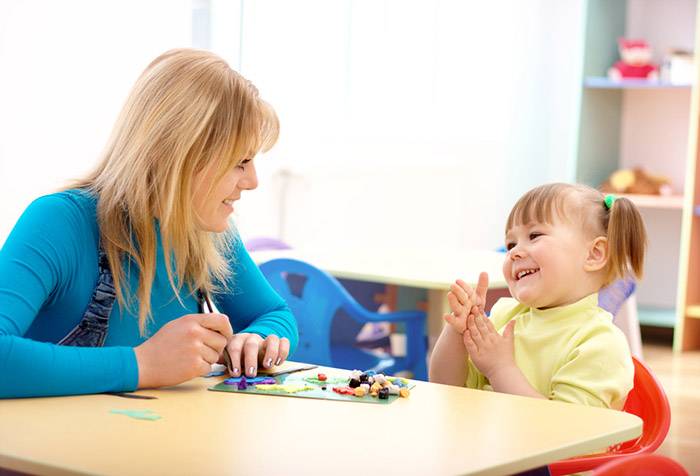
How to learn consonants: a game technique
There are many more consonants than vowels. Studying them will require more patience, effort and time. But everything will work out if you strictly follow the recommendations and take your time.
Prepare a table. Each table consists of six rows. On the top line, write or type hard consonants in blue and soft consonants in green. On the remaining lines, write short open syllables.
| BY | |
| BO | BYO |
| BOO | BYU |
| WOULD | BI |
| BE | BE |
| VYa | |
| IN | WHAT |
| VU | VYU |
| YOU | IN AND |
| VE | BE |
| GY | |
| GO | GYO |
| GU | GY |
| Gee | GI |
| GE | GE |
| DY | |
| BEFORE | DE |
| DU | DU |
| YES | DI |
| DE | DE |
| ZY | |
| ZO | ZY |
| memory | ZY |
| PS | ZI |
| ZE | WE |
| LA | |
| LO | LE |
| LU | Best Junior |
| LY | LI |
| LE | LE |
- Together with your child, sing songs of vowel sounds: in a rough low voice A, O, U, Y, E and in a high thin voice I, E, Yu, I, E.
- Say the consonants in the top line of the chart clearly. Work with 6 tables in each lesson.
IMPORTANT! Make sure that the child and you yourself pronounce the consonants clearly, so that no extraneous vowels Y or I . If the child gets used to saying D y, S y instead of the pure sounds D , S , then he will read incorrectly. The most difficult things to pronounce are the pure sounds B, V, G, D; B, B, G, D. The rest are easier, especially the deaf. Z and ZH correctly for example, is very simple. Ask your child: “How does a big mosquito buzz? Z-Z-Z. No, not Z s, but Z-Z-Z! The mosquito does not know how to say Zy , it does Z-Z-Z . How does a small mosquito buzz? ZZ-ZZ-ZZ . Komarik does not know how to say Z and, he does Z-Z-Z-Z . This is what we call these letters: Z-Z-Z and ZZ-ZZ-Z .”
- Sing the syllables in the same way as you did with the vowels.
- b in the tables and tell them that it is called a “soft sign.” Remind him of its name from time to time.
The letter b does not indicate a sound, but only INDICATES the softness of the consonant.
- Write Y . Name what this sound sounds like. Give examples of words that begin with this sound: iodine, yogurt, yogi.
the very name of the letter “ And short” later when he learns the alphabet. From time to time, remind your child about this letter by PRONING IT WITH A SOUND.
- Return to these tables several times a day and sing the warehouses with your child. Do this regularly.
- When you see that the child is doing everything correctly, replace the 2 tables with two new ones.
| MY | |
| MO | MIO |
| MU | Manchester United |
| WE | MI |
| ME | ME |
| AE | |
| BUT | NOT |
| WELL | Nude |
| WE | NI |
| NE | NOT |
The technique is the same. Sing all 6 tables daily with your child. As a result, the child will repeat the old ones and learn 2 new letters.
- Again replace the 2 tables with two new ones, etc.
If you stick to the plan “new things 2 times a week, repeat the rest of the days,” your child will learn 32 letters of the Russian alphabet in a month. Ъ to your child later, when he begins to read and encounters this letter in words.
IMPORTANT! In the Russian language there are twin sounds and warehouses: ZH-ZH, ZH-ZHYO, SH-SH, SHO-SHYO, CH-CH, CHO-CHE, SHCH-SHCH, SHCHO-SHCHYO, TSY-QI . They are spelled differently, but sound the same! Be sure to draw your child's attention to this.
A bit of "general theory"
First of all, it is important to understand that a little person’s speech develops in stages. Experienced parents probably remember that in the first months of life their baby chanted vowel sounds, then began to hum, pronouncing syllables with simple consonants, then came the first onomatopoeia (“am-am”, “av-av”) and the first words.
- Closer to one year, the child can say “mom,” “dad,” “baba,” “uncle,” “give,” and perhaps several other words. He also uses the “wrong” words (“kup-kup”, “bye-bye”).
- From one to two years old, the baby learns to formulate the first simple sentences (“I’ll have soup”, “Dad, give me”). If the syntactic structure of a sentence (subject - predicate) can be traced, no attention is yet paid to the purity of sounds: the child’s articulatory apparatus is not yet sufficiently formed for this. But the so-called “passive” vocabulary, which began in the first months, is being replenished by leaps and bounds: the child learns to understand new words, remembers their pronunciation and meaning, although he does not yet know how to pronounce them. Later they will turn into his active speech. Now he no longer just pronounces the “vocabulary set”, but listens to how he says these words and the sounds in them, and is able to evaluate whether it is correct or not.
- Around 3 years old, a child learns to repeat short poems, as well as construct complex sentences with the words “because”, “which”, “so that”. Most often, it is at this age that whistling sounds (S, Z, C) “ripe.” But even if they are still being replaced (for example, by the sound T), but the child’s intelligence is developing normally (he understands speech addressed to him, knows the names of his relatives, or that animals also have mothers and fathers) - there is no reason to worry.
- By the age of 4, the child should know general words (what are dishes, transport, toys, clothes). The pronunciation may not yet be very clear (hissing and P are the ones that suffer most often).
- At the age of 5, a child must correctly pronounce all sounds, since by this time the parts of the brain responsible for the development of speech have been sufficiently formed, and the speech apparatus has reached the required “condition” (provided that the child has been constantly trained: speech itself is not will come “out of nowhere”).
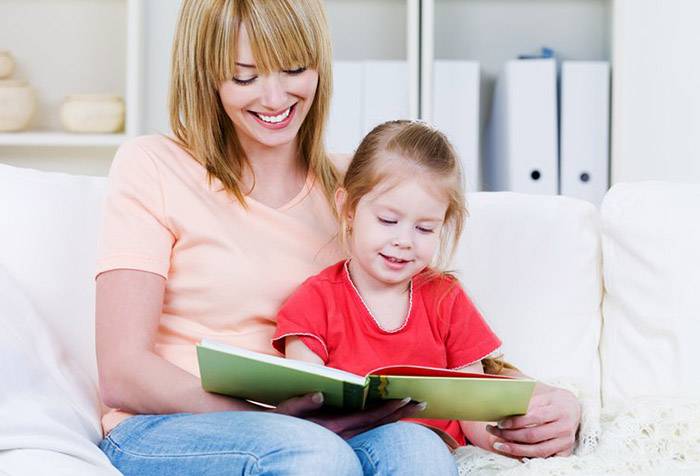
Children's coloring pages
There are plenty of such materials for teaching a child letters, and they are varied. There are coloring books where you need to color in the letters, and there are those where you need to connect the dots to make a letter. As a rule, each exercise is accompanied by a funny rhyme in order to quickly and better remember the material covered. In a word, the choice is up to the parents.
Of course, cards and magnetic alphabets are time-tested methods and auxiliary materials, but if you want to add variety to your child’s usual activities, then alternative and fun ways to teach your child letters will come to the rescue.
Learn with educational videos and apps
When considering how to quickly teach a child to read, it is worth considering the option of using useful videos and applications. Mobile applications greatly simplify the learning process. For example:
- Reader application . With the help of the application, the child will learn to read even if he does not yet know the alphabet. The program is based on the methods of Zaitseva and Doman. It includes 10 levels, of which the first 4 are working with syllables. The remaining levels are dedicated to the word.
- Doman cards . Using the program, the Doman method is practiced.
- Learning to write Russian letters . The application is aimed more at teaching writing, but it is also useful for those who are learning to read. With the help of the program, the child can easily remember what the letters look like.
- ABC, learning the Russian alphabet . The application is a very interesting game. With a special teaching method. The child catches the bold letters and forms a word from them. From the details of the designer, a puzzle is assembled - a picture that represents a word.
There are also many educational cartoons on the Internet that will help you quickly learn to read. For example, the game video Luntik helps you learn letters and prepare for school. Together with the character, children complete many interesting tasks. With their help, the baby will learn letters and alphabetical order.
Talking ABC - poster for learning the alphabet at home
We have prepared for you a review of the most interesting and fascinating alphabet posters. Choose a poster where a voice pronounces the letter and sound. It is important that the child understands the difference between them. Be patient, support the child in everything, help him.
- Talking ABC Expert. This poster contains letters, poems, songs, and the voiceover is clear and understandable.
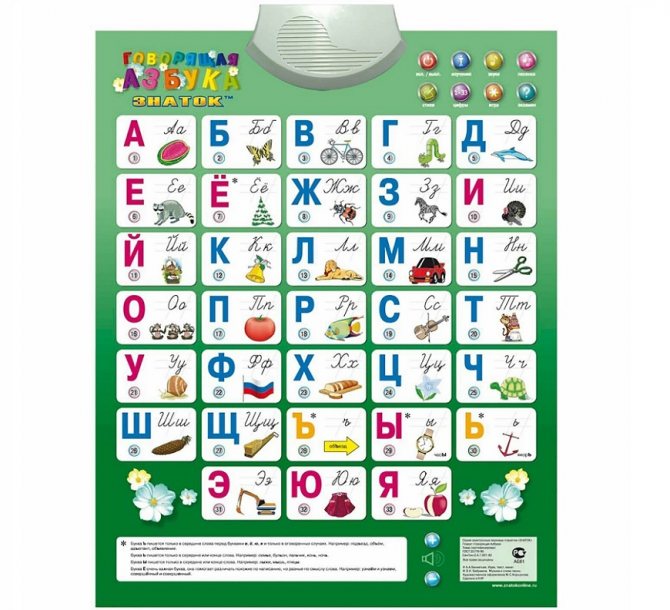
- ABC. Farm and zoo. Here the child will find fairy tales, letters, numbers, geometric shapes, animal names. The poster is bright, engaging, and the sound is clear and loud.
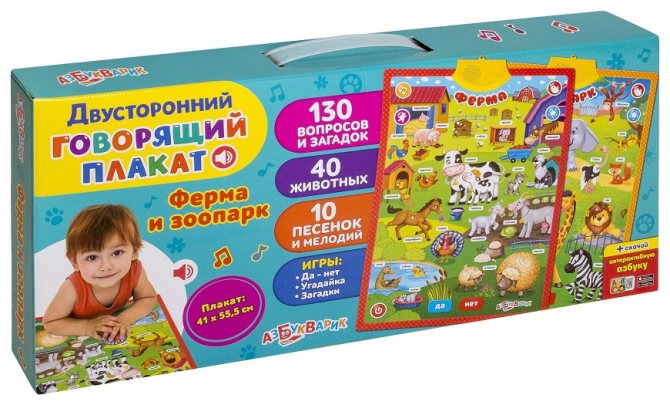
- Poster Pushkin and Russia. ABC. The canvas depicts characters from the works of Alexander Sergeevich Pushkin, they read poetry, professional voice acting is used. The buttons respond well to pressing and have an auto-off function.
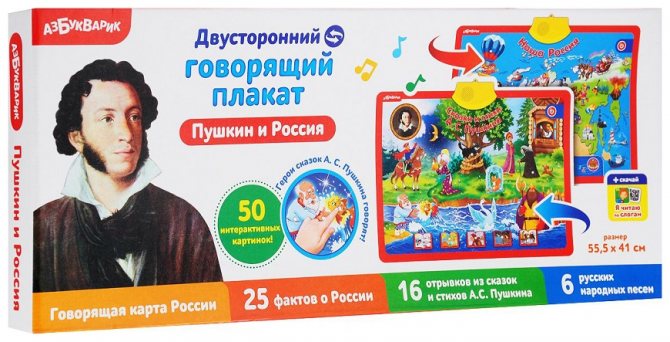
- Safety poster. Azbukvarik . – the poster introduces children not only to letters and sounds, but also to the rules of the road. Very colorful, useful and durable.
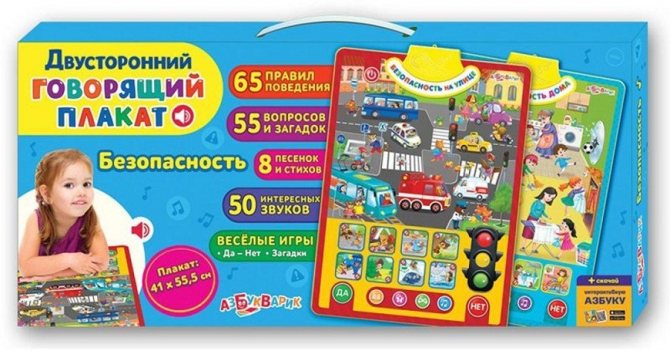
- ABC of child safety. Connoisseur. The poster teaches useful and necessary things in life - politeness, correct behavior and, of course, the alphabet. There is a knowledge test function and musical accompaniment.
